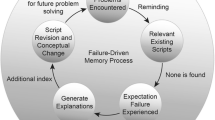Abstract
Data describing students' study orientations, in relation to their evaluations of courses and their preferences for different kinds of learning environment, are reanalysed in the light of recent suggestions that failing students perceive their learning context in atypical ways. Factor analysis and unfolding analysis demonstrate that failing students show inter-relationships between study orientations and preferences for learning environments which point to a disintegration of the coherent patterns previously reported in the full achievement range. The implications of such a disintegration of coherent patterns of perceptions are discussed in the light of case studies of individual students.
Similar content being viewed by others
References
Beard, R. and Hartley, J. (1984). Teaching and Learning in Higher Education. London: Harper & Row.
Biggs, J. B. (1985). ‘Metalearning and study processes’, British Journal of Educational Psychology 55, 185–212.
Calder, I. (1989). The Study and Learning Strategies of Students in a New Zealand Tertiary Institution. Unpublished PhD Thesis, University of Waikato, New Zealand.
Entwistle, N. J. (1987). ‘A model of teaching-learning process’, in Richardson, J. T. E., Eysenck, M. W. and Warren Piper, D. (eds.), Student Learning: Research into Education and Cognitive Psychology. Milton Keynes: Open University Press.
Entwistle, N. J. (1990). ‘Teaching and the quality of learning in higher Education’, in Entwistle, N. J. (ed.), Handbook of educational Ideas and Practices. London: Routledge.
Entwistle, N. J. and Brennan, T. (1971). ‘The academic performance of students. II. Types of successful students’, British Journal of Educational Psychology 41, 268–276.
Entwistle, N. J., Hounsell, D. J., Macauley, C., Situnayake, G. and Tait, H. (1989). The Performance of Electrical Engineering Students in Scottish Higher Education. Report to the Scottish Education Department. Edinburgh: Department of Education, University of Edinburgh.
Entwistle, N. J. and Marton, F. (1989). ‘The psychology of student learning’, European Journal of Psychology of Education IV, 449–453.
Entwistle, N. J. and Ramsden, P. (1983). Understanding Student Learning. London: Croom Helm.
Entwistle, N. J. and Tait, H. (1990). ‘Approaches to learning, evaluations of teaching, and preferences for contrasting academic environments’, Higher Education 19, 169–194.
Harper, G. and Kember, D. (1989). ‘Interpretation of factor analyses from the Approaches to Studying Inventory’, British Journal of Educational Psychology 59, 66–74.
Marsh, H. W. (1987). ‘Students' evaluations of university teachers: research findings, methodological issues, and directions for future research’, International Journal of Educational Research 11 (3).
Marton, F. and Ramsden, P. (1988). ‘What does it take to improve learning?’, in Ramsden, P. (ed.) Improving Learning: New Perspectives. London: Kogan Page, pp. 268–278.
Meyer, J. H. F. and Muller M. W. (1990a). ‘An unfolding analysis of the association between perceptions of learning context and approaches to studying’, South African Journal of Higher Education 4, 46–58.
Meyer, J. H. F. and Muller, M. W. (1990b). ‘Evaluating the quality of student learning: I. An unfolding analysis of the association between perceptions of learning context and approaches to studying at an individual level’, Studies in Higher Education 15, 131–154.
Meyer, J. H. F. and Parsons, P. (1989). ‘Approaches to studying and course perceptions using the Lancaster inventory - a comparative study’, Studies in Higher Education 14, 137–154.
Meyer, J. H. F., Parsons, P. and Dunne, T. T. (1990a). ‘Individual study orchestrations and their association with learning outcome’, Higher Education 20, 67–89.
Meyer, J. H. F., Parsons, P. and Dunne, T. T. (1990b). ‘Study orchestration and learning outcome: evidence of association over time among disadvantaged students’, Higher Education 20, 245–269.
Newble, D. and Cannon, R. (1989). A Handbook for Teachers in Universities and Colleges. London: Kogan Page.
Parsons, P. and Meyer, J. H. F. (1990). ‘The academically ‘at risk’ student: a pilot intervention programme and its observed effects on learning outcome’, Higher Education 20, 323–334.
Richardson, J. T. E. (1990). ‘The reliability and replicability of the Approaches to Studying Inventory’, Studies in Higher Education 19, 155–168.
Author information
Authors and Affiliations
Rights and permissions
About this article
Cite this article
Entwistle, N.J., Meyer, J.H.F. & Tait, H. Student failure: Disintegrated patterns of study strategies and perceptions of the learning environment. High Educ 21, 249–261 (1991). https://doi.org/10.1007/BF00137077
Issue Date:
DOI: https://doi.org/10.1007/BF00137077




